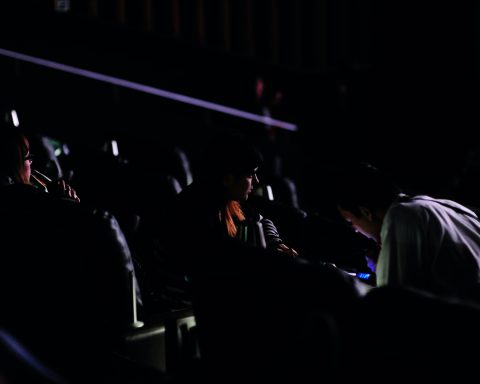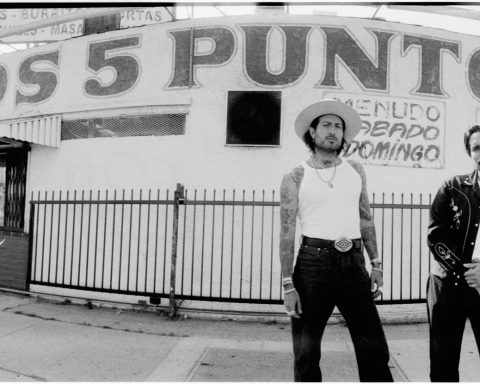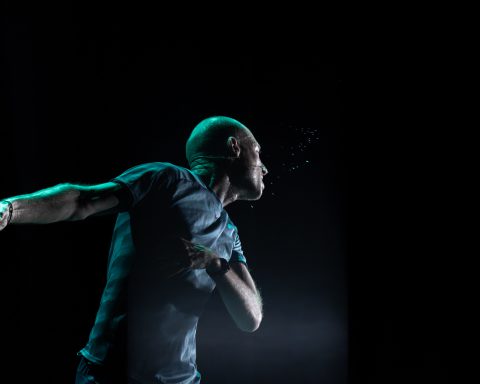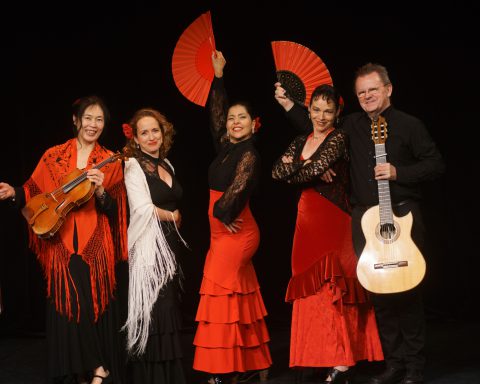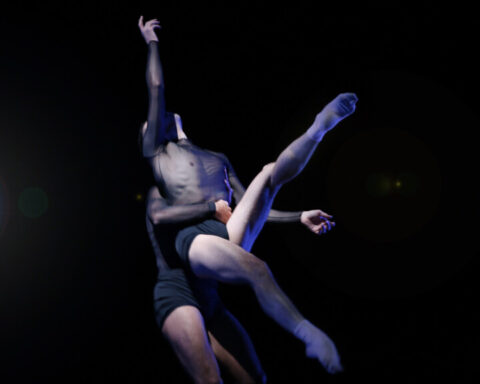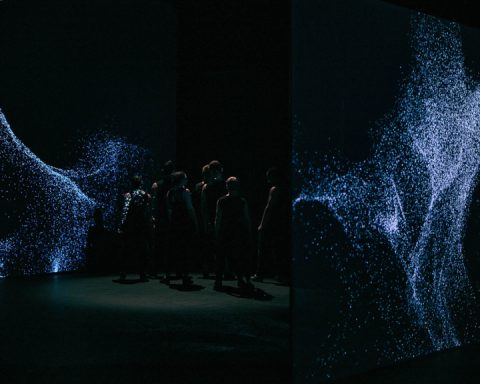We enter the room to a shimmering ghost, a silhouette drenched in golden light floating in the darkness of the LOFFT Theatre. While the silhouette completes a revolution, not unlike that of a planet, we hear sounds. Light breathing, crepitations, pressure building up, a moan and a push. In “7.1,” Zsuzsa Rózsavölgyi explores the place of women in modern history, ideas about female imagery and self representation, and she tackles the question of the “higher female calling”.
Slowly a hand rises and reveals first a curious eye, then slowly Venus herself. All the while an enigmatic track, reminiscent of a psalm, is playing, and a female voice sings: “Birdie, birdie take my letter to my beautiful Hungarian homeland. Tell him that the one who sent it, who is in sorrow, whose heart is broken in two…”
Should women serve society with their bodies and help turn around the dwindling birth rates in Europe? What do we perceive, when we see a naked female body? What does it tell us about the person, but mostly about ourselves and about the society we live in?
The first 5 minutes feel surreal and one cannot help noticing the transition from Boticelli’s “Primavera” to his “Birth of Venus,” pure raw creation in all its heft.
And with creation, it all starts.
The artist explains biological sexual differentiation, and we move pretty quickly into segregation of the sexes and the evolving perception of women’s bodies – from a mirror of the woman’s fertility and health to a sensationalised object of aesthetics and desire.

Both perceptions equally stigmatising, the artist demonstrates her inner struggle and journey in trying to reconcile the holy inner image of herself and the perception of society, fed to her with mother’s milk, inherited and kept like some rotten family jewels.
Zsuzsa explores the female struggle in all its facets.
It ranges from prompting women to add volumes to their hair by promising a “10 layers deep penetration” by a shampoo, which is sure to lure a mating partner; to Baywatch and perky boobs as a selling point even on television; to the 18 allowed North Korean hairstyles; to the European pseudo freedom of pubic hairstyles and their illuminated revelations on the women strutting them; all the way to the strange normalisation of the depiction of the female body as a functional and highly aesthetic, desired piece of meat.
The artist moves smoothly, but not without incautiously, between the layers.
We tackle the physical and emotional abuse of women as a norm, women’s sexuality and reproductive rights, men’s long lasting fight to tame the oh-so-chastity-loving pussy – while reproductive rights are kept in the hands of socially privileged men as the everlasting crusade (it turns out this story is older than Harvey)…
But she doesn’t stop there.
She contemplates heavily biased “sex education programs” and the wide spread of unsanctioned misinformation on reproductive medical care. She dissects contemporary attempts to diminish female power by, for instance, medicalising the smallest details of natural processes, such as implementing episiotomy during birth. The latter serves both to epitomise superior technology (ensuring predictability) and control nature itself (as well as female power and sovereignty).
We go through all of these ordeals in order to be “good women.” But she doesn’t break our spirits with this slideshow of subliminal horrors.
Here and there are love songs to women’s natural beauty, to their holiness, dance moves to break out of the box, moves to defend yourself when you are being attacked by someone who wants to get between your legs. There is something endearingly maternal about this, like me practising affirmations with my son.
At this point, you might be asking: How is all of this happening?
The recipe to this enticing piece is the felicitous marriage of several performance media: Zsuzsa draws on online material, pop culture references such as video clips and music, performance art (as in classical dance elements), poetry, monologues, and physical engagement with her audience.
It is absolutely captivating and speaks to each and every person sitting in the audience. By the fourth long encore, I become certain these aren’t simply German manners.
To paraphrase Ewan McLaren, director of Prague’s Alfred Ve Dvore Theatre, who moderated the post-show discussion: Zsuzsa addresses a multilayered subject soiled with violence, in an utterly humorous, elegant and non-violent way.
Zsuzsa’s imagery is rich and powerful.
There’s the laced woman in high heels stripped of her height, laying down in a pseudo S&M scenario gagged with an apple (a reference to Eve or diets?). She bends to the point of breaking in a huge room, whilst being constricted to the smallest space by a band. And this is just an example.
Another impressive image is the artist explaining the struggles of Saint Thekla, whilst a cross shines on her. It’s a reference to the chaste, illuminated and crucified female. A deeply moving highlight is the section where Zsuzsa starts by explaining the benefits of the release/swing technique.
When you swing your arms like this and jump around, you don’t tense up as much and you don’t feel as much pain and sadness.
She then goes on to detail her personal experience with abortion and how this coloured her relationship with her family and her partners, and reordered her priorities.
This experience was also the ultimate revelation that her body is the gate between life and death.
She tells us all this while swinging her arms, wearing pink jogging pants and a shirt with a unicorn on it. It feels like a pyjama party on a bed of cinders of personal tragedy. At that point I feel I am not the only one who wishes she can swing her arms with the performer.

On her motivation to develop this performance before the advent of the #MeToo movement, Zsuzsa mentions that Facebook, among other social media outlets, would suggest videos and articles for her to watch and read. She felt the urge to put this puzzle together and narrate with her voice and body.
This is how this multimedia collage came to be during her residency at Baryshnikov Arts Center in New York, and later graced the Leipzig LOFFT Theatre and Dresden’s Societaetstheater. And just like a child, this performance grows with the artist, as she keeps expanding the performance with pertinent experiences and pieces.
It is during the Q&A section that we get a glimpse into the artist’s soul.
Zsuzsa explains that she and her mother and the rest of her family would play the song “Madárka, Madárka”- which she opened her performance with – on her way to her grandma’s house and back. As she does that, she chokes up and tears betray a nostalgia for something beyond broken, but also resilient womanhood.

She shows us the broken child, she shows us the broken vessel, which she is gluing piece by piece with molten gold.
By Rima Chakaroun
Rima is an academic researcher and writer based in Leipzig.
“7.1” was performed in late May 2018 as part of Off Europa: Open Hungary.This and other pieces important to the independent dance scene, have found their voice at the LOFFT. They have officially moved from their previous venue in Lindenau, but don’t despair. This is great news! After the summer break, there will be four productions at different locations in town before they move into their new space at Spinnerei at the beginning of 2019.

